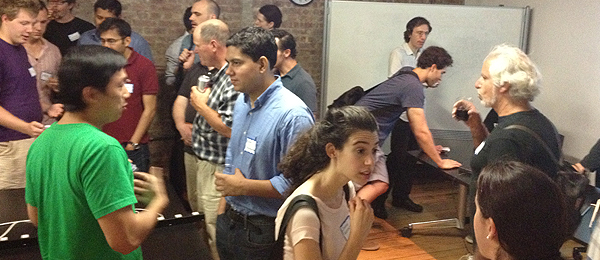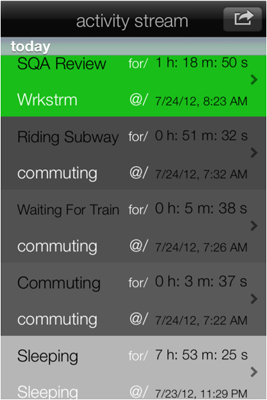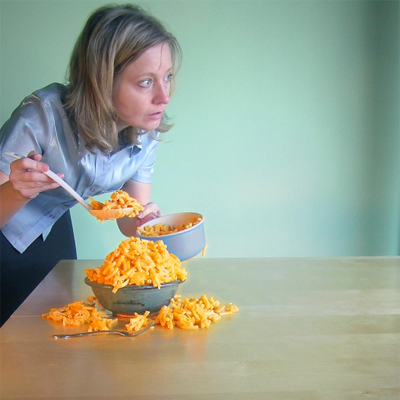New York QS Show&Tell #17 Recap
Steven Dean
August 14, 2012
At our last meetup in New York, we had a packed house at NYU’s ITP, one of our great supporters of QS here in NY. Thank you to my co-organizers, Ben Ahrens and Brian Gallegos, who helped pull together this recap for the blog.

DEMO HOUR
Brad Hammonds and Stan Berkow gave a large-scale, real time demonstration of their web app StudyCure – an online platform that allows its users to create and run interactive experiments geared toward understanding their health in the best possible way. Each experiment is set up in an if…then… fashion (eg. IF I focus on breathing during the day, THEN I will be less stressed). This keeps experiments clean and simple and helps participants make meaningful use of their data that leads to positive change. StudyCure will eventually be able to compare your data with a range of population norms within a given experiment, giving you the ability to benchmark your results against the larger community.
Lead by Lisa and Dr. Mike Gerstenfeld, MD, along with their team of developers, Cloud2Health solves the problem of decentralized and disconnected health data from health & fitness apps and medical records. It does this by providing its customers with one centralized site which serves as “a single source of truth.” In an age of ever-increasing data streams, wouldn’t that be nice? A video presentation was given in a private demo room and projected on the wall while QS experts and enthusiasts crowded around. View their comprehensive video demonstration on the site!
Back in the main demo room, Kuan Huang and partners gave QS members a trial run on Feelytics.me – their iPhone app that allows you to log your ever changing emotional state and associate with your peers based on how they are feeling. The app is characterized by cute and expressive faces ascribed to each emotion and the ability to connect with others, centered on the feelings the faces portray.
Another and very different emotional state tracking platform was being demonstrated across the table by Dan Bretl. Emotish allows you to take a photo of yourself in a particular state (e.g., blissful, serene, calm, excited, etc.) and tag it accordingly. These labels then function a lot like hash tags on twitter and allow you to filter and search for photos of other users in a particular mood or mind state. This app offers a lot of potential and creative leeway for it’s users to search, follow, filter, crowd-source, and of course track their own patterns of emotional change as depicted by a photo journal.
Smart Diaper – this demo was just as cool as it is practical – one of those, “why didn’t I think of that” product ideas. Conceived and created by Yaroslav Fabishenko while taking a 4-hour car ride with his two kids in the back, the Smart Diaper harbors an embedded urinalysis patch that measures ketone bodies, ph balance, presence of certain proteins, and a host of other useful information for keeping on top of your babies health every time they… do their business. The diaper is linked with a phone app that lets you snap a picture of the test patch for the data to be logged and analyzed. Based on the analysis, parents may then, for instance, receive a message suggesting that their child be sent for a checkup or even a particular screening.
SHOW&TELL TALKS
Following the demo hour, we had four inspiring show&tell talks.
Autobiography Through Quantification
 Christian Monterroza was inspired by On Kawara, an artist that self tracked each day of the year through paintings and newspaper headlines. He wanted to do something similar with his life and asked himself the question, “How can I know if what I’m doing is wrong if I never track what I do?” So he started a regimen of tracking. He found himself using several tools but soon became fed up and created his own tool. He used On Kawara’s work as an example of changing the power of a simple time stamp. He started calling his own self tracking time stamps “self portraits.”
Christian Monterroza was inspired by On Kawara, an artist that self tracked each day of the year through paintings and newspaper headlines. He wanted to do something similar with his life and asked himself the question, “How can I know if what I’m doing is wrong if I never track what I do?” So he started a regimen of tracking. He found himself using several tools but soon became fed up and created his own tool. He used On Kawara’s work as an example of changing the power of a simple time stamp. He started calling his own self tracking time stamps “self portraits.”
His tracking consisted of sending postcards to friends of the city he was in and recorded everywhere he went in that city. He took this concept and gave it a name, Wrkstrm. To help with this, he built a tool that did the monitoring for him. It’s an application on his phone that automatically tags when he’s in certain regions.
Christian gained a lot of value from his tracking. He learned that it’s not all about numbers. It’s about the perspectives his experiences provided. He learned that sometimes we record the wrong things. For example, we spend a lot of time tracking obvious moments but serendipitous moments are getting lost. He also learned that passive tracking is better than active tracking and that gamification doesn’t really help. In the end, he succeeded in optimizing his day.
I Shot Myself: 365 Days of Self-Portraits
 Next up was Sharla Sava with her photo project. Her project was to take a photo every day. But the rules were that a) she could never miss a day and b) she had to appear somewhere in the photo. She added the photos to a group pool on Flickr and collected feedback from the members. She found that having an immediate and responsive audience is addictive. She wondered if her self portraits were just for her and not really for anyone else. But she learned that self portraits, while not very practical, are also not trivial. They can be a site for public dialog.
Next up was Sharla Sava with her photo project. Her project was to take a photo every day. But the rules were that a) she could never miss a day and b) she had to appear somewhere in the photo. She added the photos to a group pool on Flickr and collected feedback from the members. She found that having an immediate and responsive audience is addictive. She wondered if her self portraits were just for her and not really for anyone else. But she learned that self portraits, while not very practical, are also not trivial. They can be a site for public dialog.
For example, she explored how the body functions in journalism to send a message. She discovered how certain gestures communicating different messages based on the reactions from the Flickr group. She began to explore and capture a state of mind that’s difficult to convey.
While self portraits may not be meaningless, a question she set out to answer is how do we quantify the meaning? She found that the numbers are related to external factors. For example, Flickr tracks views, etc. She was able to draw conclusions from this data, but it didn’t really allow her to measure meaning. This project ultimately taught her something meaningful about her connection to the world.
Audio Jack Sensor Hack
This was Joel Murphy’s second time presenting at QS New York and this time, along with Leif Percifield, they showed everyone a project to find a better way of getting sensor data into a smart phone or tablet. The basis for their project is that once the data is in there, you can do anything with it. But getting the data into these devices is sometimes difficult. In fact, it’s fairly easy if you have a large processor, but an 8bit processor like the Arduino doesn’t work very well.
Their goal is to create a cheap way to develop hardware that gets data to a phone or tablet easily. So they figured out a way to essentially turn speaker outputs into digital outputs (analog waves to digital). They created a mini-IDE on the phone where you can type in calculations and mine the raw data.
Joel and Lief are hardware hackers trying to get more powerful data transfer from sensors and other devices in a cheaper way. In the end, they showed a quick and dirty etch-a-sketch that displayed the power of their new device. Joel’s notes from the talk are at Phone Jack Hack.
Spaced Repetition: A Cognitive QS Method for Knowledge Acquisition
The final presenter of the night was another veteran of the Quantified Self circuit, Roger Craig. Roger presented on the concept of spaced repetition. Spaced repetition is not about how fast we learn, but how fast we forget. Roger described how Hermann Ebbinghaus, a quantified self pioneer, spent decades of time on memory experiments with himself and discovered what he called the “forgetting curve.” The forgetting curve says that when you remember something, you will forget it, but the decay gets flatter and flatter the more often you are exposed to it.
In the 1930’s, Cecil Mace developed the concept of spaced repetition. With this, you take the forgetting curve and create essentially an algorithm to ping yourself with a piece of information you’d like to remember. You then optimize this process of review. So some information is reviewed more frequently when you first learn it, but then it’s refreshed less often later on as you are able to show fast recall. The advantage of this process is that you learn where to ‘aim’ your learning based on the speed at which you can recall.
Roger has tried many applications to practice spaced repetition and currently uses Anki. He learned that it’s a great way for self trackers to optimize learning.



